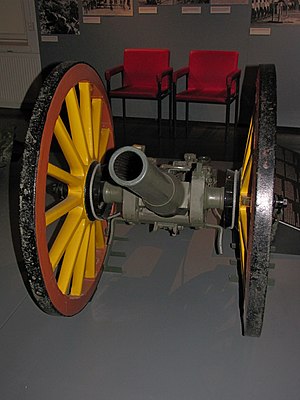Type 31 75mm Mountain Gun
| Type 31 75mm gun | |
|---|---|

Type 31 75 mm mountain gun at the Hämeenlinna military museum.
|
|
| Type |
field gun mountain gun |
| Place of origin | Japan |
| Service history | |
| Used by |
|
| Wars |
Russo Japanese War World War II |
| Production history | |
| Designer | Arisaka Nariakira |
| Produced | 1898 |
| Number built | Approximately 620 |
| Specifications | |
| Weight | .330 tonnes (730 lb) |
| Barrel length | 1.06 m (3 ft 6 in) L/13.3 |
|
|
|
| Shell | 6 kilograms (13 lb) |
| Caliber | 75 millimetres (3.0 in) |
| Recoil | semi-rigid cable/spring system |
| Carriage | pole trail |
| Elevation | -5° to +38° |
| Muzzle velocity | 487 m/s (1,600 ft/s) |
| Effective firing range | 2-3 rounds/minute |
| Maximum firing range | 6,500 m (7,100 yd) |
The Type 31 75 mm mountain gun (三十一年式速山砲 Sanjūichinen-shiki Sokusanhō?) was the main field gun deployed by the Imperial Japanese Army in the Russo-Japanese War of 1904-1905.
The Type 31 was introduced in 1898, with the “Type 31” designation indicating that the gun was developed in 31st year of reign of Emperor Meiji. Designed by Colonel Arisaka Nariakira, it had a barrel made of steel, which improved the range and accuracy of the gun over the earlier 7 cm mountain gun, which had a bronze barrel. The Type 31 used smokeless powder cartridge shots, and had a semi-rigid recoil system using cables connected to a set of springs. It had a range of approximately 7800 meters, using a 6.0 kilogram explosive shot. The Type 31 also came in a lighter mountain gun version, which had a shorter range (4300 meters). Approximately 620 were produced and deployment to combat units was completed by 1902. The gun remained in service to the end of World War II.
...
Wikipedia
